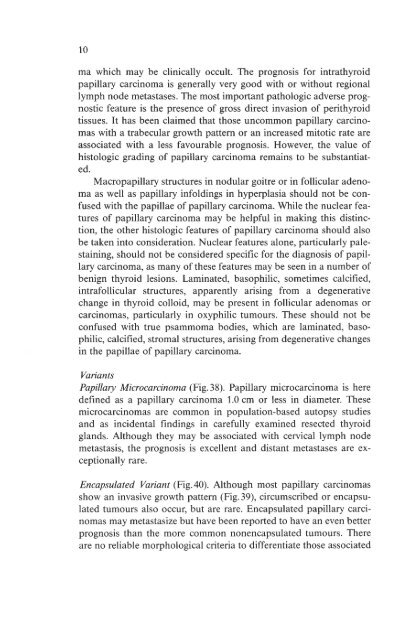Histological Typing of Thyroid Tumours - libdoc.who.int - World ...
Histological Typing of Thyroid Tumours - libdoc.who.int - World ...
Histological Typing of Thyroid Tumours - libdoc.who.int - World ...
You also want an ePaper? Increase the reach of your titles
YUMPU automatically turns print PDFs into web optimized ePapers that Google loves.
10<br />
ma which may be clinically occult. The prognosis for <strong>int</strong>rathyroid<br />
papillary carcinoma is generally very good with or without regional<br />
lymph node metastases. The most important pathologic adverse prognostic<br />
feature is the presence <strong>of</strong> gross direct invasion <strong>of</strong> perithyroid<br />
tissues. It has been claimed that those uncommon papillary carcinomas<br />
with a trabecular growth pattern or an increased mitotic rate are<br />
associated with a less favourable prognosis. However, the value <strong>of</strong><br />
histologic grading <strong>of</strong> papillary carcinoma remains to be substantiated.<br />
Macropapillary structures in nodular goitre or in follicular adenoma<br />
as well as papillary infoldings in hyperplasia should not be confused<br />
with the papillae <strong>of</strong> papillary carcinoma. While the nuclear features<br />
<strong>of</strong> papillary carcinoma may be helpful in making this distinction,<br />
the other histologic features <strong>of</strong> papillary carcinoma should also<br />
be taken <strong>int</strong>o consideration. Nuclear features alone, particularly palestaining,<br />
should not be considered specific for the diagnosis <strong>of</strong> papillary<br />
carcinoma, as many <strong>of</strong> these features may be seen in a number <strong>of</strong><br />
benign thyroid lesions. Laminated, basophilic, sometimes calcified,<br />
<strong>int</strong>rafollicular structures, apparently arising from a degenerative<br />
change in thyroid colloid, may be present in follicular adenomas or<br />
carcinomas, particularly in oxyphilic tumours. These should not be<br />
confused with true psammoma bodies, which are laminated, basophilic,<br />
calcihed, stromal structures, arising from degenerative changes<br />
in the papillae <strong>of</strong> papillary carcinoma.<br />
Variants<br />
Papillary Microcarcinoma (Fig.38). Papillary microcarcinoma is here<br />
defined as a papillary carcinoma 1.0 cm or less in diameter. These<br />
microcarcinomas are common in population-based autopsy studies<br />
and as incidental findings in carefully examined resected thyroid<br />
glands. Although they may be associated with cervical lymph node<br />
metastasis, the prognosis is excellent and distant metastases are exceptionally<br />
rare.<br />
Encapsulated Variant (Fig.a0). Although most papillary carcinomas<br />
show an invasive growth pattern (Fig.39), circumscribed or encapsulated<br />
tumours also occur, but are rare. Encapsulated papillary carcinomas<br />
may metastasize but have been reported to have an even better<br />
prognosis than the more common nonencapsulated tumours. There<br />
are no reliable morphological criteria to differentiate those associated
















